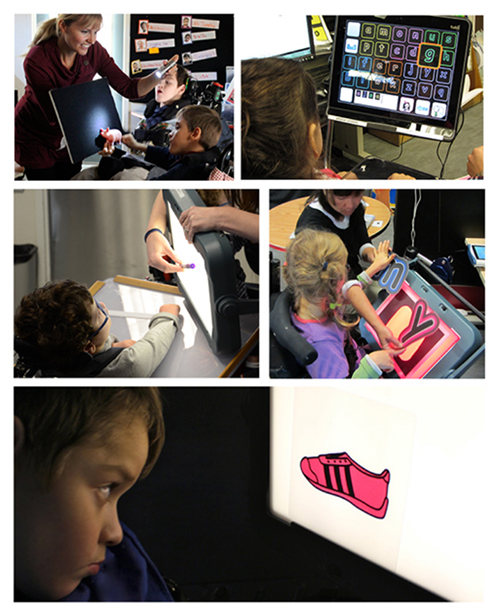Cortical Visual Impairment (CVI) is a major cause of low vision in children in the developed and developing world due to increasing survival in pediatric and neonatal care (Phillip & Dutton, 2014). CVI is also the most prevalent visual impairment for students at The Bridge School. Our students with CVI and Severe Speech and Physical Impairment (SSPI) have challenges that require specialized and appropriate vision accommodations that support them in meeting their educational potential.
Meeting the educational goals necessary to provide Bridge School students optimal opportunities for participation in areas of communication, education, and literacy, requires assessments and interventions that specifically address the unique needs of our students with CVI.

In order to provide individualized learning experiences for our students, our teachers engage in an ongoing process of observation, documentation, reflection and planning. Bridge School’s curriculum planning framework allows our educational teams to flexibly personalize each student’s curriculum such that instruction supports and builds upon current communication skills, maximizes academic and social participation, ensures desired educational outcomes and contributes to a positive quality of life. As each personalized curriculum is developed, we draw from core content and specialized curricular areas based on the student’s grade level and unique learning needs. Ongoing observation and curriculum-based assessment results are used to make decisions regarding an appropriate, grade level educational program for the student. This assessment helps determine the child’s current levels of performance and how areas of need can be addressed in The Bridge School context. In collaboration with each child’s respective local school district, we develop an Individual Education Plan (IEP) with annual goals and benchmarks.
The IEP process is the foundation of a quality education for every child with a disability. In the process of developing the IEP, family members, classroom staff, consultants and school district administrators have the opportunity to work together to improve educational outcomes for children with disabilities. These individuals pool knowledge and expertise to design an educational program that will help the student participate and progress in the general curriculum and guide the delivery of special education supports and related services for the student. Each Bridge School student has an Individualized Education Program (IEP) that is designed specifically for that student.
At the outset of the IEP process, each student is assessed in all areas related to his/her disability. The assessment results are used to make decisions regarding an appropriate education program for the student, including the development of individualized goals and benchmarks and the identification of accommodations and supports. Goals are written such that the child can reasonably accomplish them in a year.
Annual IEP goals address areas of the general curriculum that are directly affected by the student’s disability. Areas of the general curriculum that are not affected by the student’s disability do not need to be specifically addressed in the IEP.
Goals in the IEP may address areas of concern in the academic curriculum, social or behavioral, physical or other educational needs. The goals must be measurable, meaning that it must be possible to ascertain whether or not the student has achieved the goals. Each annual goal is broken down into benchmarks that allow team members to measure and report progress toward the goal on a trimester basis.
IEP goals are aligned with appropriate grade level Common Core State Standards (CCSS) to ensure our students have experiences with the general education curricular content. There are significant benefits to aligning IEPs to learning standards, including higher expectations for students, focused and collaborative instruction aligned to assessments and increased exposure to general education curricular content. Importantly, alignment of IEP goals with CCSS enhances collaboration and understanding among Bridge School teams and receiving local school district teams. When IEPs are aligned to CCSS, expectations for learning and participation increase and the overall team perspective shifts from focusing on what is preventing a student from accessing the curriculum instead to emphasizing what needs to be done to support the student in gaining greater access to the general curriculum.
In order to ensure that each Bridge School student can effectively demonstrate competencies in an applicable area of the general curriculum, it is important for the IEP team to consider the designated supports and accommodations that the student requires to participate successfully. These supports and accommodations must be detailed in the IEP and the professional responsible for the delivery of these services designated.
Coming Soon
Coming Soon